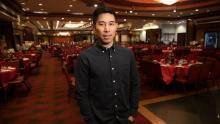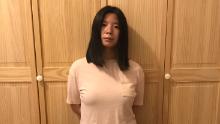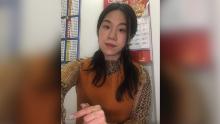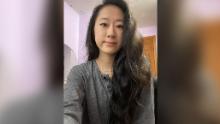Unemployment benefits: Claims from Asian Americans have spiked 6,900% in New York. Here’s why
Jing Fong’s dining room is massive; a destination for banquets and weddings, it can hold up to 794 people — and on weekends, there has historically been a long wait to get in for dim sum. But on that day, Lam counted just 36 guests.
Business had started to slow as early as January and was down 80%. All of the parties in March were canceled, too, he said.
“That day, I decided, you know what? Let’s just close for the rest of the weekdays,” Lam told CNN Business, adding that he was thinking about staying open on the typically busier weekends.
As long as the restaurant could cover workers’ wages each day, Lam felt it was still worth it to stay open. But “it became more and more obvious that we couldn’t even cover the payroll for that day,” Lam said.
Soon after, Lam made the final decision to furlough 310 staff members across two locations and encourage them to apply for unemployment benefits. He declined to say whether he has filed for benefits, too.
Across New York, businesses like Lam’s have shut down and Asian American workers have filed for unemployment benefits at extraordinary rates. In the state, about 147,000 self-identified Asian workers have filed initial unemployment claims in the last four weeks alone, up from just 2,100 during the same period last year.
That’s a 6,900% increase — by far the largest percentage increase experienced by any one racial or ethnic group.
In contrast, claims were up 1,840% for white workers, 1,260% for black workers, and 2,100% for Hispanic and Latino workers in New York.
What’s the cause? Academics and members of the community point to several potential factors ranging from xenophobia to Asian Americans working in industries hard hit by the pandemic, including food and services. Many Asian workers also say they began social distancing earlier in the crisis than others — a factor that led some to close down businesses even before official lockdowns.
Lam, for instance, believes the main reason his restaurant began to lose business starting in January is because of “Chinese people practicing social distancing early.” One regular customer told him that their parents hadn’t left the house in a month since January except to get coffee and the newspaper.
“Jing Fong was first established around 1978,” said Lam, who took over daily operations of the business after his father, uncle and grandfather. “And we’ve never seen anything like this before.”
Low unemployment rates never told the full story
All of those underlying factors are at play now in New York’s data, as unemployment claims spike disproportionately for the Asian community.
Low-wage workers hit first
One theory from experts to explain the high unemployment claims is that many Asian Americans work in industries that were hardest hit by lockdowns — places like restaurants, small shops and nail salons.
While overall, Asian Americans are more likely to work in education and health services than retail and restaurants, those who were hardest hit by layoffs and furloughs early in the pandemic probably were in low-wage service sectors.
Wellington Z. Chen, executive director of the Chinatown Partnership, a nonprofit that focuses on revitalizing the neighborhood, said that Asian communities’ reliance on industries like food services and personal care meant they bore the brunt of shelter-in-place orders. “You can’t cut nails from six feet away, right?” said Chen. “A lot of people are not going to hang on. [They’re] not going to make it.”
On the opposite end of the income-spectrum, however, they also represent 35% of software developers, 20% of physicians and surgeons, and 23% of pharmacists. Those white collar jobs are generally more resilient to layoffs —but economists expect those sectors could be hit later in the pandemic as well.
But occupations alone likely don’t explain the disproportionate rise in Asian unemployment claims as other groups work in hard-hit industries too. That’s why experts also point to other potential explanations.
Racism and xenophobia as a factor
Business owners and workers told CNN Business that recently, racism and xenophobia against Chinese and Chinese-looking people have been a factor in driving business closures and unemployment claims.
In some of New York City’s predominantly Asian neighborhoods, business owners told CNN Business that foot traffic took a downturn months before lockdowns were in place. Not only that, but Asian employees and business owners said they were also apprehensive about commuting to work, as people would give them strange looks and news about anti-Asian hate crimes was spreading across their social media networks.
Lin Weng, 25, who lives in Sunset Park, a neighborhood known as Brooklyn’s Chinatown, applied for unemployment benefits after she was furloughed from her coffee shop on March 22. But while customers were still coming into the shop, she said, she experienced an incident in which she was associated with the coronavirus potentially due to her race.
“This lady walked in… and the first thing she asked me was ‘do you guys have the coronavirus?'” said Weng, who added that the woman proceeded to order an iced coffee but then changed her mind and left. “And I’m just [thinking] like, ‘are you asking me or telling me?'”
In addition to racism and xenophobia, Asian businesses in neighborhoods like Chinatown and Flushing have faced caution from their own communities as well. Some Asian customers have drastically cut back their interactions with Asian-run businesses, as owners noticed huge drops in traffic.
Early social distancing hurt Chinese businesses
Some essential businesses, including Asian-run supermarkets in Flushing and laundromats in Brooklyn, have closed despite being allowed to operate under shelter-in-place rules.
The Korean American Dry Cleaners Association o
f New York estimates that 70% of its 1,500 members will soon or already have temporarily closed their operations, according to Ahyoung Kim, small business project manager at the nonprofit Asian American Federation. Reasons varied from workers being unwilling to come in, to some contracting the virus, or because business had dropped off.
Some Chinese American workers who have applied for unemployment told CNN Business they agreed with their bosses’ decision to close, even if it meant that they lost income.
Zixian Tang, 25, who lives in Flushing, Queens, worked at a popular karaoke place that closed on March 15.
Even if his boss had not chosen to close the place, Tang said in comments translated by CNN Business from Mandarin Chinese, “I’m not willing to go to work because I’m afraid” despite having rent to pay. “The death toll is too high,” he said.
Jennifer Feng, 38, a nail technician at an ordinarily bustling mall salon in Flushing told CNN Business in comments translated from Mandarin that the salon decided to cancel its many upcoming appointments and close on March 16, several days ahead of New York’s stay-at-home order. While she can apply for unemployment, she said she is waiting for her stimulus check to hit first to see if she needs the extra benefits.
Feng said she believes Flushing stores closed early because the Chinese American community acted faster in taking precautions, from social distancing early to wearing face masks, compared to those in other groups.
Economists from Columbia University, New York University, and the University of Massachusetts Boston said they can’t know for sure whether xenophobia or caution were reasons for the high amount of unemployment claims from Asian Americans. It’s too early, and data on that is unavailable so far.
A different story for South Asian communities
While workers of East Asian backgrounds say they grappled with shop closures, social distancing and xenophobia early on in the pandemic, South Asian neighborhoods in Queens were still pretty crowded at the end of March.
“I went to Patel Brothers the first week of the shutdown,” said Annetta Seecharran, executive director of the Chhaya Community Development Corporation, a nonprofit that serves the South Asian community, referring to a destination Indian grocery store in Jackson Heights, Queens. “It was life as usual, like nobody had actually heard of any pandemic.”
Mohammed Uddin, 42, told CNN Business that although the virus’ first case in New York was announced on March 2, only when the death toll began to rise in mid-March did he begin to realize it was a dangerous situation.
Compared to stores in Flushing, the ones in Jackson Heights — a diverse neighborhood known for Indian, Bangladeshi and Latino American residents as well as other groups — stayed open longer, Uddin observed.
Uddin said he left his job as an Access-a-Ride driver on March 17 because it involves chauffeuring elderly and ill patients from their homes to hospitals and he felt it was too risky. His friends, drivers who introduced him to the job, quit too, he said.
“I was very scared of getting anything,” he said. He developed a cough and fever that worried him. He lives with his wife, a 2-year-old, a 7-year-old and his mom, 67, and dad, 75, both of whom have diabetes.
“If I got any other job, which is not close to people, of course I’ll go to work,” he said.
Small numbers in 2019 meant a large spike for 2020
Another factor behind the large jump: Asian Americans filed very few claims last year, so that’s partly why their percentage gains were higher than any other group, said Christian Moser, assistant professor of economics at Columbia Business School. “The larger number… will come from the fact that we’ve started out with such a low level to begin with for Asian Americans,” he said.
The small base numbers in 2019 can be potentially explained in part by pride, said Ahyoung Kim, the small business project manager. And now, it’s possible Asian American people are rethinking that stance given the combination of racism and economic fallout they’ve experienced during the pandemic.
“I can’t speak for all Asian cultures, but at least in the Korean community, there has been a bit of shaming, in a cultural sense that you can’t really demand stuff from the government,” she said. “There’s a huge shift in the community. Those that are asking are now realizing, ‘I can take this money and we should take this money because there really is no choice.'”
Undocumented immigrants missing from the numbers
immigrants are ineligible to apply. About 238,000 undocumented Asian immigrants live in New York state, according to the Migration Policy Institute, a nonpartisan think tank. There’s no data on how many of them have lost jobs recently. Sora Lee, 23, who lives in Bayside, Queens, told CNN Business that her whole family is ineligible.
Both her parents are undocumented, while she and her sister worked jobs that were paid in cash. All four of them lost jobs recently, although her dad is unemployed due to an injury unrelated to coronavirus.
Her mom, who requested to remain anonymous because of her immigration status, is a nail technician who lost her job after her salon closed. “I would like to be working because of the money, but at the same time, it’s very dangerous because of the virus, so it was a good idea to close down,” she said in comments translated from Korean by her daughter.
Thanks to a babysitting gig, Lee does have some income right now, but she’s the only one in the family who does and her mother said she’s worried she won’t be able to pay her bills. Rent, electricity, cable, internet, car insurance and life insurance payments due soon total up to $2,600 and the family is leaning on credit cards and about $1,000 left in savings. She said she wished that undocumented immigrants could be eligible for some sort of relief.
The long road ahead
“I’m going to predict that this is going to happen again,” Kim told CNN Business. “I think it was part discrimination but also part other people dropped out of the labor market, they didn’t even look for jobs. But Asians kept looking for jobs and being counted [as unemployed.]”
New York’s skyrocketing unemployment numbers could be just the beginning. And with many working in sectors hard hit by coronavirus and potentially facing discrimination, it could be difficult for Asian Americans to find jobs once New York opens back up again.
Wilson Tang, 41, owner of Nom Wah Tea Parlor — a dim sum restaurant that first opened in 1920 — said almost all of Manhattan’s Chinatown has shut down. He has furloughed about 55 employees in Chinatown and is keeping a location north of Little Italy open only for takeout and delivery.
“I have told the people that we laid off to please go exercise that right and use the unemployment benefits that they’ve paid towards and the company has paid towards and whatever stimulus checks or whatever resources they can to survive and weather this storm,” he said.






